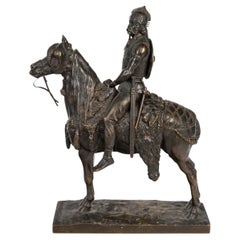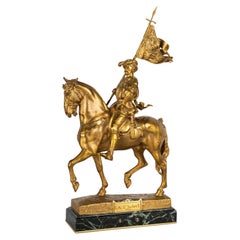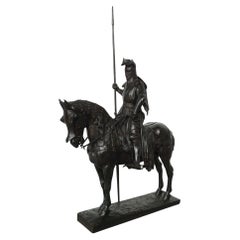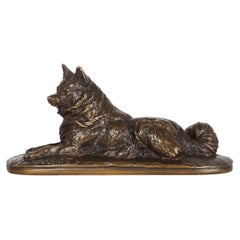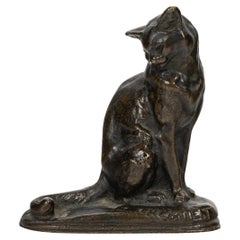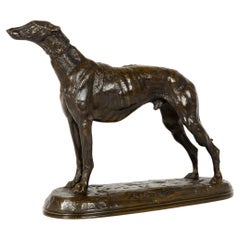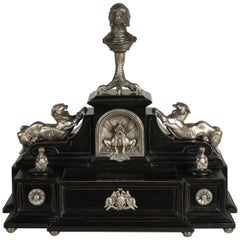Emmanuel Fremiet
French, 1824-1910
Emmanuel Frémiet was born in Paris, France in 1824 and was brought into an upper middle-class family that had very close ties to the world of art. His family was filled with great artists and this included his Cousin Sophie who married a famous sculptor called Francois Rude. Emmanuel’s mother was also an accomplished artist who constantly encouraged him and brought him up into the world of art. At the age of five, he was already was receiving formal training in art in a private school. The start at a young age meant he was able to be accepted at the spectacular Ecole des Arts Decoratifs School at the age of sixteen.
Throughout this period he learned everything he needed to then become employed by Werner as his head lithographer within a year, whose duties were to prepare drawings of both animals and men. After a long period of convincing by Sophie and Emmanuel, Francois Rude took Emmanuel as a pupil in his studio to further his learning in modeling and sculpture work.
Throughout his young life, he spent a lot of time in zoological gardens and participated in dissections of any animals which had passed away during this time. By the age of seven, he had been exposed to a wide range of different wild animals. To further Emmanuel’s path in art, he was appointed the successor of Antoine Louis Barye as Professor of Drawing after Antoine’s death in 1875. With this new position and like many other great sculptors, he spent a lot of time studying and drawing at the morgue and even went to various embalmers across Paris. This was all of his training to give him the exact measurements and to be able to reproduce the muscle and bone structure of the many men and animals that he witnessed.
His first sculpture was exhibited in the Paris Salon in 1843 when he was nineteen and he continued to exhibit his magnificent sculptures for the rest of his life at the Salon. He was even awarded various medals and awards from many of his pieces. As he began with the bronze sculptures, he made many small animal bronzes with very fine detail which are nowadays highly sought after by collectors and museums alike. There were many sculptors during this time that crafted pieces in which showed a cruel nature, but Emmanuel was known for the soft and gentle pieces of work which often were amusing. At the age of twenty-five, he was to receive more commissions than any other sculptor before or during his time. It became near impossible to be able to walk the streets without seeing one of Emmanuel’s many smaller bronze sculptures.
This amazing sculptor continued crafting works, but also proceeded to train new sculptors, taking on near twenty pupils each time. Unfortunately, this great sculptor passed away in 1910.| Average Sold Price |
| $4,239 |
| Materials |
| Related Creators |
Bronze Sculpture of a Gaulish Chief, Signed FREMIET.
By Emmanuel Fremiet
Located in Saint-Ouen, FR
Bronze sculpture of a Gaulish chief, signed FREMIET.
Bronze sculpture signed FREMIET, representing a Gaulish chief, 19th century, Napoleon III period.
H: 37cm, W: 26cm, D: 8,5cm
Category
19th Century French Napoleon III Antique Emmanuel Fremiet
Materials
Bronze
'Jeanne d'Arc' Stunning Early Salon version of the Famous Sculpture by Fremiet
By Emmanuel Fremiet
Located in Forest Row, East Sussex
A late 19th century bronze sculpture depicting Jeanne d'Arc. A stunning early salon version of the famous Joan of Arc in the Place des Pyramides in Paris. Wonderful rich brown patina...
Category
Late 19th Century French Antique Emmanuel Fremiet
Materials
Bronze
$19,099
H 29.14 in W 18.9 in D 4.34 in
French 19th Century Gilt Bronze & Marble Sculpture by Emmanuel Frémiet
By Emmanuel Fremiet
Located in Los Angeles, CA
A traditional gilt bronze sculpture by Emmanuel Frémiet standing on a marble base, portraying St. Hubert riding a horse while he shows a flag depicting Jesus crucified, symbolizing h...
Category
19th Century French Antique Emmanuel Fremiet
Materials
Marble, Bronze
$9,600
H 27.5 in W 13.25 in D 5 in
Louis d'Orléans late 19th century bronze sculpture by Emmanuel Fremiet
By Emmanuel Fremiet
Located in Forest Row, East Sussex
A late 19th century bronze sculpture by Emmanuel Fremiet depicting Prince Royal Louis 1st Duke of Orléans. A later cast of the original sculpture erected in the courtyard of the Chât...
Category
Late 19th Century French Antique Emmanuel Fremiet
Materials
Bronze
$14,531
H 24.41 in W 15.36 in D 7.88 in
French Antique Bronze Sculpture of Husky Dog by Emmanuel Fremiet
By Emmanuel Fremiet
Located in Shippensburg, PA
A good lifetime casting by Charles More numbered 215, it captures the entirely relaxed spirit of the recumbant husky dog with its bushy tail bouncing and eye...
Category
19th Century French Romantic Antique Emmanuel Fremiet
Materials
Bronze
Bronze Sculpture of a Cat by Emmanuel Fremiet, 19th Century.
By Emmanuel Fremiet
Located in Saint-Ouen, FR
Bronze sculpture of a cat by Emmanuel Fremiet, 19th century.
A bronze sculpture of a cat by Emmanuel Frmiet, 19th century, Napoleon III period.
H: 8cm, W: 7cm, D: 4cm
Category
19th Century French Napoleon III Antique Emmanuel Fremiet
Materials
Bronze
French Antique Bronze Sculpture “Standing Greyhound” by Emmanuel Fremiet
By Emmanuel Fremiet
Located in Shippensburg, PA
EMMANUEL FREMIET
French, 1824-1910
"Chien Levrier"
Patinated bronze signed E. Fremiet in naturalistic base cold-stamped 85, a Charles More cast
Item # 411PRB18X
An exquisite mo...
Category
19th Century French Romantic Antique Emmanuel Fremiet
Materials
Bronze
$6,900
H 9.25 in W 9.5 in D 3.88 in
Neo-Greek Inkwell by C.G. Diehl, E. Frémiet and J. Brandely, France, Circa 1867
By Emmanuel Fremiet, Charles-Guillaume Diehl, Jean Brandely
Located in PARIS, FR
Signed Diehl à Paris.
Wood and silvered copper inkwell. Central drawer ornamented with an escutcheon and flanked by two small lateral drawers forming two containers, surmounted by a lid representing a nestling. Central niche ornamented with a winged creature. Inkwell flanked by two felines. Toped by a penholder representing a Moorish head resting on an eagle claw.
This exceptional piece was realized thanks to the collaboration of ornemanist J. Brandely, sculptor E. Frémiet and cabinet-maker C.-G. Diehl. The motif of the fantasy creature dear to Diehl, is to be seen on the famous cabinet made by him in 1867 and now exhibited at the Metropolitan Museum of Art in New York (Inv. 1989.197).
Arriving in Paris in about 1840 Charles-Guillaume Diehl (1811-1885) founded his cabinet making and decoration firm at 19 rue Michel-le-Comte in 1885. His workshops produced elegant little pieces of furniture in rosewood and thuja and novelties with bronze and porcelain embellishments (see “Les ébénistes du XIXème siècle”, D. Ledoux-Lebard, Ed. de l’amateur, 1982, p.164). It was his luxury boxes, however (liqueur cellarettes, cigar cabinets, games boxes, cashmere cases, jewelry cases) which assured Diehl’s renown (see “l’Art en France sous le Second Empire”, Exposition Grand-Palais, Paris, 1979, p.133). Already rewarded with a bronze medal at the Universal Exhibition of 1855 in Paris, he exhibited a jardinière with china columns and a liqueur cabinet at the Industrial Arts Exhibition in 1861.
In collaboration with the designer Jean Brandely (active from 1867 until 1873), Diehl renovated his decorative repertory and created astonishing pieces of furniture in the Grecian style which had a dazzling success at the Universal Exhibition in Paris in 1867, where his cabinets also won a silver medal. Certain motifs were so typical of Diehl’s work that they received extensive commentary by the art critic J. Mesnard in his book “Les Merveilles de l’Exposition Universal de 1867” (vol. II, pp. 133 & 149). He writes of a table of which “the pendant bearing hooks and the fan shaped radiating motif which ornaments the entablature are engraved with love” (p. 133) and a jewelry case where “The head in fine Grecian style makes up the essential part of the fine gilt bronze ornamentation” (p. 149).
For this Universal Exhibition Diehl also formed a partnership with two famous sculptors: Emile Guillemin (1841-1907) who carved the relief for a mahogany sideboard with galvanic gilt bronzes (Orsay Museum, Paris, Inv. O.A.O. 992) and Emmanuel Frémiet (1824-1910) who executed the low relief for a cedar medal cabinet...
Category
1860s French Greek Revival Antique Emmanuel Fremiet
Materials
Copper
$22,165
H 17.72 in W 19.69 in D 9.06 in
Browse all Furniture from Emmanuel Fremiet
Shop NowEmmanuel Fremiet Sale Prices
This data represents a recent sample of sales made on 1stDibs during the specified years. All sales are anonymized.
| Sold Date | Sold Price | Category | Material | Creation Year | |||||||||||
|
| $4,239 |
Average sold price of items in the past 12 months |
| $1,081-$10,250 |
| Sold price range of items in the past 12 months |
Emmanuel Fremiet furniture for sale on 1stDibs.
Emmanuel Fremiet furniture are available for sale on 1stDibs. These distinctive items are frequently made of metal and are designed with extraordinary care. There are many options to choose from in our collection of Emmanuel Fremiet furniture, although gold editions of this piece are particularly popular. If you’re looking for additional options, many customers also consider furniture by Charles Valton, Thiebaut Freres, and Achille Collas. Prices for Emmanuel Fremiet furniture can differ depending upon size, time period and other attributes — on 1stDibs, these items begin at $1,019 and can go as high as $85,714, while a piece like these, on average, fetch $2,800.
